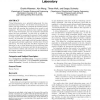Free Online Productivity Tools
i2Speak
i2Symbol
i2OCR
iTex2Img
iWeb2Print
iWeb2Shot
i2Type
iPdf2Split
iPdf2Merge
i2Bopomofo
i2Arabic
i2Style
i2Image
i2PDF
iLatex2Rtf
Sci2ools
SIGCSE
2008
ACM
2008
ACM
Operational experience with a virtual networking laboratory
Virtual laboratories are a potential replacement for standard laboratory facilities. Use of these virtual resources can reduce cost and maintenance overheads for teaching institutions while still ensuring that students have access to real equipment. Previous work indicates that students respond well to such environments, but one important operational aspect has been overlooked. In this work, we consider instructor overhead by comparing the amount of work required to teach courses with and without the use of a virtual laboratory. In particular, we examine two graduate computer networking courses, each taught with the standard softwareonly approach and then taught later with the Open Network Laboratory. Our data show that the effort required by the instructor to use a virtual laboratory is not much more than in a software-only environment, and that the increased interaction between student and instructor can be beneficial as the student questions are primarily focused on fundamental net...
Education | Important Operational Aspect | SIGCSE 2008 | Standard Laboratory Facilities | Virtual Laboratory |
| Added | 14 Dec 2010 |
| Updated | 14 Dec 2010 |
| Type | Journal |
| Year | 2008 |
| Where | SIGCSE |
| Authors | Charlie Wiseman, Ken Wong, Tilman Wolf, Sergey Gorinsky |
Comments (0)

